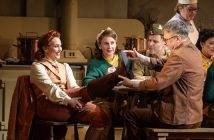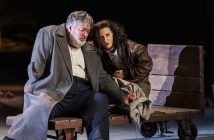The 1951 film was a colourful reverie starring Gene Kelly and a 17-year-old Leslie Caron that was nominated for eight Oscars, won six (beating A Streetcar Named Desire to Best Film), and earned Kelly a special nod towards his choreographic skill. Now An American Paris has been brought alive on the stage, its multi-Tony Award-winning run transferring from Broadway to Oxford Street’s Dominion Theatre.
And that grand sweep of Gershwin blasts you into nostalgia right from the off, only this time you get to feel the tingle of a live orchestra performing it. One notable benefit of such a vast theatre is the ample space, which indulges what was always an unapologetic feast of music and dance – there is room for both a decent band in the pit and for dancers to tread every inch of the boards above it. Which they do, and with utterly seamless fluidity (even when rearranging the set) thanks to the exquisite new choreography of Christopher Wheeldon.

A Brit in the Big Apple, former Royal Ballet dancer Wheeldon has made his name across the globe choreographing works for companies from the Bolshoi to the New York City Ballet, where he remains in residence. He’s the one responsible for the Royal Ballet’s hugely successful Alice’s Adventures in Wonderland and The Winter’s Tale in recent years, and it is this storytelling ability that so benefits An American in Paris now. His vision has the grace of Astaire, the wit of Kelly and the sheer dynamism displayed in West Side Story (perhaps not surprising since Wheeldon was lucky enough to work with the late Jerome Robbins, who choreographed the latter, when he first arrived in New York).
Maintaining a balletic anchor, Wheeldon toys with vintage styles from jazz to ballroom, even making a friendly – yet searing – jab at the stuffier classical tableaus customary in the 1940s, when the show is set, with a comically rigid ballet performance put on for a cocktail party that contrasts the sinuous movements elsewhere. Rob Fisher’s delightfully syncopated arrangement of ‘I Got Rhythm’ not only references Kelly’s tap dancing in the original, but allows Wheeldon to play about with the movements onstage, utilising bicycles, electric generators and all sorts to get said rhythm across.

Such is the bliss of George Gershwin’s music. But as a hotchpotch of his works from other musicals, it was the standalone orchestral piece now sitting at the core that prompted Hollywood producer Arthur Freed to make the film in the first place. Hence, there was never much of a story to tell other than the concept of some American guy experiencing the French capital. But Craig Lucas has beefed up the plot: the lives of the two love rivals of former-GI Jerry for his Parisian crush Lise are weaved in more craftily, and wealthy American Milo becomes less desperate, more business-minded as she funds the ballet production that brings Lise, Jerry and the various threads together.
As Milo, Zoë Rainey is dignified and charismatic, with similarly high quality support from David Seadon-Young and Haydn Oakley as Adam and Henri respectively (Oakley’s ‘Stairway to Paradise’ is joyous). But it is the lead duo who really set the show alight, having honed their chemistry on Broadway. Played by The New York City Ballet’s Robert Fairchild, Jerry is picture perfect, his gravity-defying leaps across park benches, counter tops and who knows what done with ease and flair as he woos the more timid Lise. Having left the Royal Ballet for this role, Leanne Cope is dainty and suitably coy. As the show reaches its peak, she lets go entirely, and this dream sequence is nothing short of thrilling as her fierce black costume imbues her with good old-fashioned sass. Cope’s French accent may get a bit exaggerated at times (“Eel come along, ze man I love”) but it’s not like anything is underdone in this production, so what the heck?

Yet, amid this lightness and brightness (literally: the colours of the costumes and set are knockout), is a dark undertow: we are watching a Paris still reeling from the Second World War, a Paris not yet recovered from the terror of occupation. It makes the residents jumpy, scared of loud noises, quick to duck and slow to trust. It confuses the personal relationships this scarred population can forge. And whilst this aspect didn’t really come across in the film, it is the very first image we are shown on the stage. This production reminds us that without darkness, one cannot appreciate light, and it is precisely that which makes the whole thing sparkle so genuinely.
An American in Paris at the Dominion Theatre, Tottenham Court Road, London W1T 7AQ, currently booking until 30th September 2017. For more information and tickets please visit the website.




